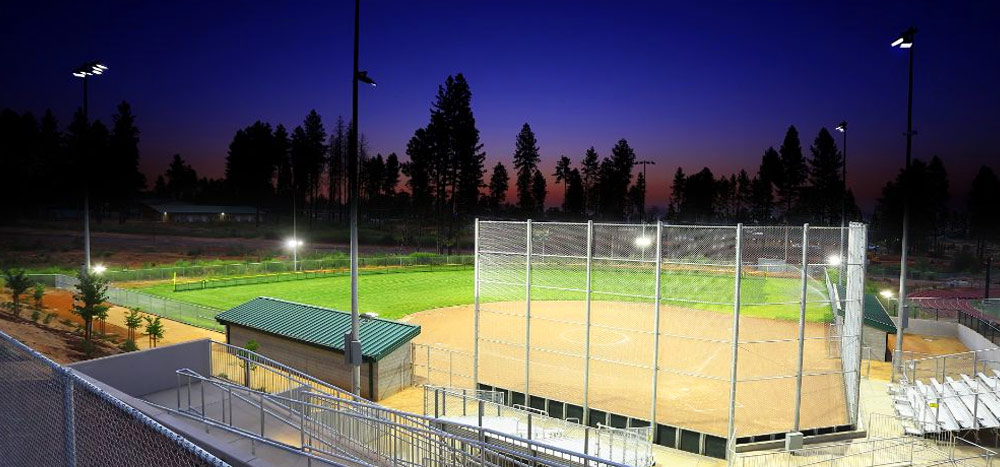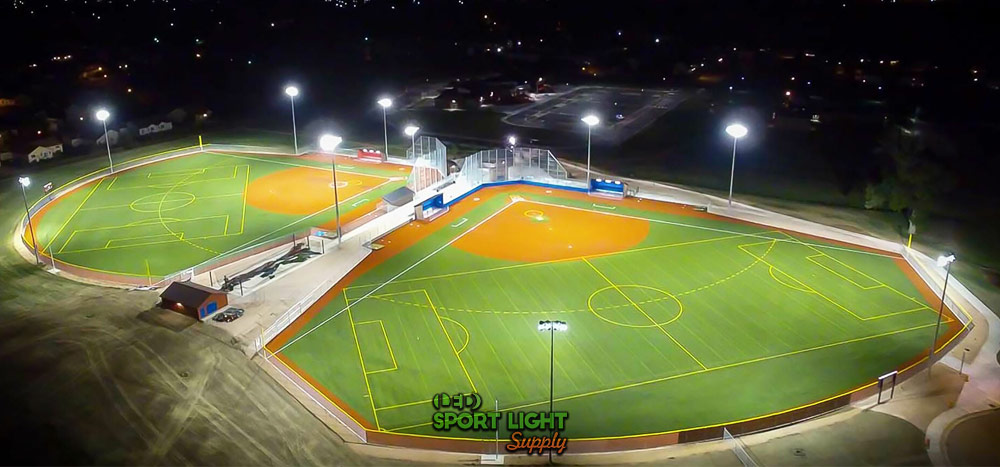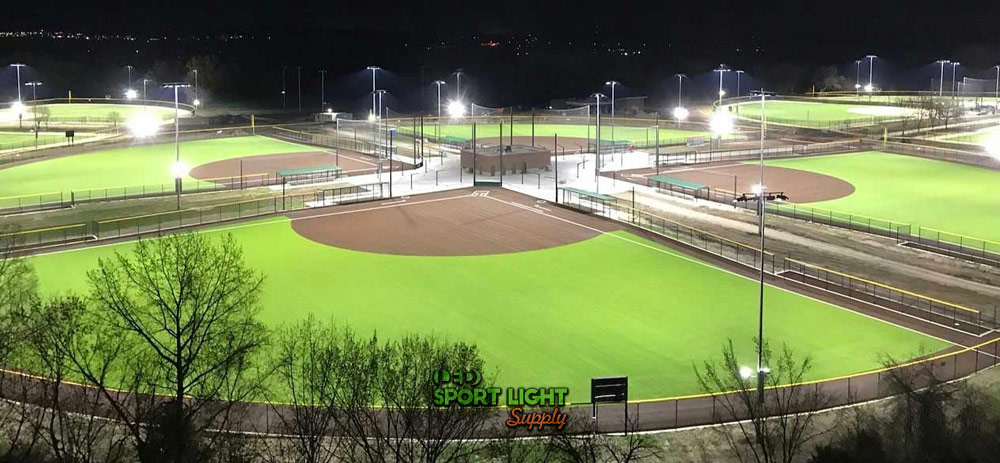Softball is a dynamic team sport that, while closely related to baseball, has several distinctive features. Played with a larger, softer ball than its baseball counterpart, softball takes place on a diamond-shaped field that is smaller, with bases 60 feet apart, compared to the 90 feet in baseball. The game is characterized by its underhand pitching style, a unique aspect that affects the ball’s speed and trajectory. This sport is enjoyed by individuals of all ages and skill levels, ranging from youth leagues to high school, collegiate, and professional levels. Its inclusive nature is highlighted by the presence of men’s, women’s, and co-ed leagues, making it a popular choice for many across different demographics.
Proper lighting is crucial for both player safety and spectator enjoyment in softball. Adequate illumination ensures that players can see the ball, teammates, and field clearly, which is essential for accurate plays and minimizing the risk of injuries. It also enhances the overall viewing experience for spectators, providing a clear, vibrant visual of the game. Inadequate lighting can lead to poor visibility, resulting in potential collisions, errors, and disputes due to inaccurate umpire calls. Additionally, well-balanced lighting improves the field’s aesthetics, making the game more appealing and professional, especially for televised and high-profile events. Proper lighting thus plays a vital role in maintaining the integrity and enjoyment of the sport.
Table of Contents
ToggleThe History of Softball Field Lighting
Early Days of Softball
The game of softball has its origins in baseball, a sport with a rich history dating back to the 1800s. Softball, however, is a more recent development, emerging in the late 1800s and early 1900s. Although the exact origins are somewhat debated, it is widely believed that softball was developed in Chicago in 1887. One popular story recounts that a group of baseball enthusiasts, playing indoors during the winter, used a boxing glove as a makeshift ball. The glove, being too soft to travel far, led them to shorten the bases and create a new game known as “indoor baseball.”
Over the decades, softball evolved and gained popularity. By 1933, the first organized softball league was established in Chicago, and the inaugural national softball tournament took place in 1936. The sport continued to expand, with various amateur, collegiate, and professional leagues emerging globally. Today, softball is enjoyed by millions of people of all ages and has become a popular Olympic sport.
Evolution of Lighting Technology
The advancement of lighting technology has significantly impacted the development of softball as a sport. Initially, softball fields were illuminated by a mix of natural light and incandescent bulbs. These early lighting systems were rudimentary, offering limited visibility, which posed challenges for both players and spectators.
With technological progress, lighting systems improved. Fluorescent bulbs and metal halide lamps became common in the latter half of the 20th century. These newer systems offered brighter and more consistent illumination compared to incandescent bulbs. They also boasted longer lifespans, making them more cost-effective and easier to maintain.
Current Softball Field Lighting Standards

National Governing Body (NGB) Regulations
In the United States, USA Softball serves as the National Governing Body (NGB) for the sport, overseeing its development and promotion. As the recognized national body for softball by the United States Olympic Committee (USOC), USA Softball sets the standards for various aspects of the sport, including field lighting.
For recreational softball, USA Softball recommends a minimum of 50 footcandles of light. For high school and collegiate play, the requirement increases to 75 footcandles, and for professional levels, it is set at 100 footcandles. These recommendations consider the field size, base distances, and the level of play to ensure adequate visibility for both players and umpires.
Additionally, USA Softball provides guidelines on the placement and orientation of lighting fixtures to ensure even distribution and to minimize shadows and glare. These standards are crucial for maintaining safety and fairness during play.
International Softball Federation (ISF) Regulations
The International Softball Federation (ISF) is the global governing body for the sport, setting rules and regulations for international play, including lighting standards. The ISF’s lighting requirements mirror those of USA Softball, recommending a minimum of 50 footcandles for recreational play, 75 footcandles for high school and collegiate levels, and 100 footcandles for professional play.
These standards ensure that the field lighting provides sufficient brightness for various levels of play, from amateur to professional. The ISF also stipulates specific guidelines for the placement and orientation of lights to ensure uniform illumination and to prevent issues such as shadows or glare, which could compromise player safety and game fairness.
Professional Softball Leagues
Professional softball leagues, such as the National Pro Fastpitch (NPF) in the United States and the Japan Professional Softball League (JPSL) in Japan, impose stringent lighting standards to meet the high demands of competitive play. These leagues often require a minimum of 100 footcandles of illumination, reflecting the need for superior visibility and performance conditions for elite athletes.
In addition to brightness requirements, these leagues have detailed guidelines on lighting placement and orientation. The goal is to achieve optimal lighting conditions that ensure fair play and enhance the spectator experience by eliminating shadows and reducing glare.
Factors to Consider When Choosing Softball Field Lighting

Brightness
Brightness is a crucial aspect when selecting lighting for a softball field. Measured in lux or footcandles, brightness determines how well the field is illuminated. Adequate brightness ensures player safety and enhances the overall game experience. If lighting is too dim, players may struggle to see the ball and the field clearly, which can increase the risk of accidents and make it difficult for umpires to make accurate calls. Conversely, excessive brightness can cause glare and shadows, negatively impacting visibility and enjoyment.
The recommended brightness levels vary depending on the level of play. For recreational softball, a minimum of 50 footcandles is generally recommended. High school and collegiate games typically require 75 footcandles, while professional play demands 100 footcandles. These standards are designed to provide optimal visibility for players and umpires while balancing the need to avoid excessive glare and shadows.
Color Temperature
Color temperature, expressed in kelvins (K), defines the hue of a light source, ranging from warm to cool tones. For softball fields, selecting the right color temperature can influence the visibility and ambiance of the game.
A warmer color temperature (around 2700K-3000K) may create a more relaxed atmosphere, suitable for recreational play. In contrast, a cooler color temperature (between 4000K-5000K) is often preferred for high-level play, as it enhances clarity and creates a more vibrant, energetic environment. The choice of color temperature affects how players and the field appear, with warmer tones providing a softer look and cooler tones offering a sharper, more dynamic view.
LED vs. Metal Halide
When choosing between LED and metal halide lighting, each technology has its benefits and drawbacks.
LED lighting is favored for its energy efficiency and longevity. LEDs consume about 75% less energy than traditional incandescent bulbs and can last up to 50,000 hours or more. They produce minimal heat, which is advantageous in warmer climates, and offer flexibility in color temperature and brightness levels. This makes LED lighting a cost-effective and adaptable choice for many softball fields.
Metal halide lighting, a more traditional technology, provides bright and consistent illumination. Although it has a shorter lifespan and is less energy-efficient compared to LEDs, it can deliver intense light suitable for high-level play. Metal halide lamps also have higher upfront costs and require more maintenance due to their susceptibility to heat and frequent bulb replacements.
Maintenance
Maintenance is an important consideration, as it impacts the long-term performance and costs of the lighting system. LED lights typically require less maintenance due to their durability and long lifespan. They do not produce significant heat, reducing the risk of failure and the need for frequent bulb changes.
Conversely, metal halide lamps necessitate more maintenance. Their shorter lifespan and higher heat output increase the likelihood of failure and the need for regular bulb replacements. Additionally, maintaining the field and related infrastructure, such as electrical systems and poles, is crucial to ensure the system’s reliability and minimize downtime.
Cost
The cost of a lighting system affects both the initial investment and long-term operational expenses. LED lighting generally comes with a higher upfront cost but offers lower energy consumption and reduced maintenance needs, leading to lower overall operating costs. This can result in a better return on investment over time.
In contrast, metal halide lighting may have a lower initial cost but can incur higher operating costs due to greater energy usage and frequent maintenance. When budgeting for a lighting system, it’s essential to consider both the initial expense and the long-term costs associated with energy consumption and maintenance.
Future Developments in Softball Field Lighting Technology

Increased Energy Efficiency
The drive toward greater energy efficiency is a key trend in the evolution of lighting technology. Future developments in softball field lighting are expected to focus on further reducing energy consumption while maintaining or enhancing performance. Advances in LED technology and other innovative lighting solutions promise to deliver even more efficient systems. These improvements could result in substantial cost savings for field owners and operators by lowering energy bills and reducing the environmental impact of lighting operations.
Advanced Controls and Automation
The integration of advanced controls and automation systems represents a significant leap forward in lighting technology. Future softball field lighting systems are likely to feature sophisticated control mechanisms that allow for real-time adjustments to brightness and color temperature. For instance, lighting systems may automatically adapt based on factors such as the time of day, weather conditions, or the intensity of play. Such automation would enhance user convenience and ensure optimal lighting conditions throughout different stages of the game.
Improved Visibility and Safety
Future lighting systems are set to push the boundaries of visibility and safety on the field. Innovations in optics and lighting configurations are expected to reduce shadows and minimize glare, providing clearer and more uniform illumination. Enhanced visibility will improve player performance and safety, as well as the accuracy of umpire calls. The use of cutting-edge technology to design lighting systems that address specific visibility challenges could transform the way games are played and viewed.
Enhanced Aesthetics
Customization in lighting design is becoming increasingly sophisticated, allowing for a broader range of visual effects and atmospheres. Future developments may include the ability to create dynamic lighting scenarios, such as changing colors, patterns, and intensities, to enhance the overall game experience. This could involve incorporating programmable LED systems that offer diverse lighting effects, making the field visually striking and engaging for both players and spectators. Enhanced aesthetics will contribute to a more immersive and memorable experience, potentially attracting more fans and creating a vibrant atmosphere around the sport.
These advancements in lighting technology promise to revolutionize softball field illumination, making games safer, more enjoyable, and visually impressive. As technology continues to evolve, the potential for new innovations in lighting design will likely offer even more benefits to the sport.
Conclusion
The evolution of softball field lighting has significantly enhanced the game, ensuring both player safety and spectator enjoyment. From its early days with basic incandescent bulbs to the advanced LED systems of today, lighting technology has continuously improved. Future developments are set to push the boundaries further, with increased energy efficiency, sophisticated control systems, and enhanced visibility and aesthetics. As technology progresses, these innovations will not only optimize performance and safety but also create more engaging and visually captivating experiences for players and fans alike.
